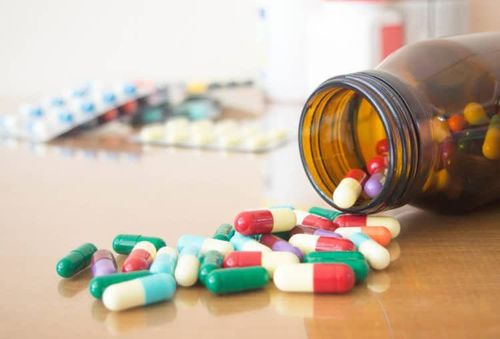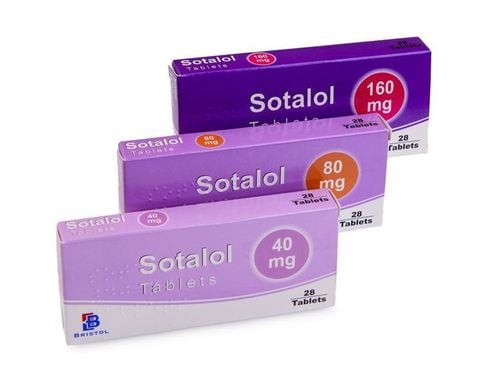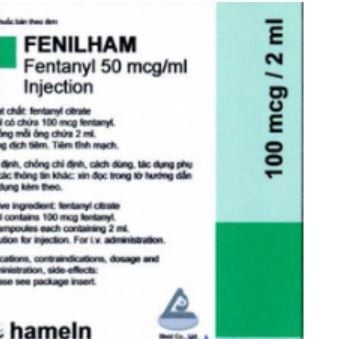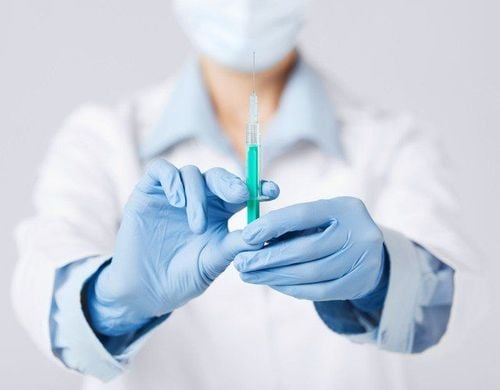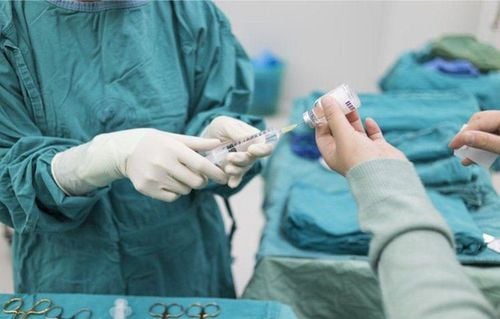This is an automatically translated article.
The article is expertly consulted by Anesthesiologist, Resuscitation and Anesthesia - Department of General Surgery & Anesthesia - Vinmec Hai Phong International General Hospital.
Anesthesia, anesthesia is a common medical technique, aimed at temporarily losing sensation or losing consciousness so that the patient does not feel pain. As with many other medical techniques, the side effects of anesthesia can lead to some complications for the patient.
1. Side effects of anesthesia
1.1. Anesthesia poisoning Anesthesia poisoning occurs when the concentration of local anesthetic in the patient's blood is too high. Each type of anesthetic has a certain allowable concentration. Depending on each drug, the doctor needs to monitor the patient with the appropriate dose. For example:
Drug Marcain, etidocaine allowable concentration is 1-2mcg/ml plasma drug Lidocaine, prilocaine allowable concentration is 5mcg/ml plasma Mepivacaine drug allowable concentration is 4mcg/ml plasma Cause of Local anesthetic poisoning is caused by:
Giving the patient an overdose of local anesthetic Injecting the wrong anesthetic into the blood vessel Anesthesia in areas rich in blood vessels such as: perineum, cervix... Manifestations of local anesthetic toxicity It occurs mainly in two organs, the central nervous system and the cardiovascular system, specifically:
Headache, ringing in the ears, mental panic, anxiety, vision disturbances, tongue and lips numbness, taste disorders sense. More seriously, the patient may convulsions, coma, loss of consciousness. Hypoxia and acidosis or hypercapnia can lead to elevated levels of toxicity. Treatment: At this point, it is necessary to immediately stop the injection and give the patient oxygen. If the patient has seizures, give the patient a benzodiazepine or a barbiturate. Alternatively, the short-acting muscle relaxant succinylcholine can be used for intubation.
If the concentration of anesthetic in the blood is very high, many times higher than the allowable threshold, it will affect the cardiovascular system. Patients will present with bradycardia, hypotension, arrhythmias caused by anesthetics that inhibit myocardial contractility, conduction and peripheral vasodilation. Treatment: Give the patient oxygen, use vasopressors, give fluids, treat cardiac arrhythmias. When the side effects of anesthetic drugs affect the cardiovascular system, it is very difficult to treat, with a high probability of death.
* When being diagnosed with anesthetic poisoning, treat according to the anesthetic poisoning emergency protocol with 20% Lipid solution
1.2. Allergy to anesthetics Patients with allergy to anesthetics may have local manifestations such as erythema, urticaria, edema, dermatitis... More seriously, the patient will have a systemic allergy with similar symptoms. mentioned above and bronchospasm, cardiovascular collapse...
Anesthetics of the ester group are more likely to cause allergies than the amide group.
1.3. Local toxicity Local anesthetics can cause damage to the local anesthetic site in cases of high concentrations of anesthetics, injection of large quantities of anesthetic, or chemicals in the anesthetic.

2. Side effects of anesthesia
2.1. Respiratory Complications Tracheal Intubation Complications The cause of complications is the wrong placement of the tube and stomach, placing the deep tube to one side or trauma when inserting the tube.
When intubation, need to listen to 2 lungs to check tube position.
Bronchospasm Patients with bronchospasm, if awake, will have stridor, wheezing, rapid breathing, difficulty breathing. If the patient has been anesthetized, breathing will be difficult, sometimes impossible.
Caused by drugs causing anaphylactic reactions or patients with bronchial asthma, there is a response to local irritation in the respiratory tract, especially patients who smoke or have chronic bronchial disease.
Bronchospasm can occur due to damage stimuli sensing the presence of secretions, blood in the trachea, pharynx, endotracheal intubation, peritoneal traction, surgical stimuli..
To limit the possibility of bronchospasm due to side effects of anesthetics, attention should be paid: Before anesthesia, ensure that the patient is in deep sleep, spray local anesthetic before proceeding to insert the instrument. bronchi; Pre-anesthesia for high-risk patients; Check the endotracheal tube, gently pull it out when there is irritation in the bronchial spur; Deep anesthesia with inhalation anesthetic, intravenous anesthetic can be used when performing artificial respiration is difficult. Increased inspiratory oxygen concentration; Using inhaled bronchodilators, beta-adrenergic antagonists...
Laryngeal spasms The cause of laryngospasm is due to superficial anesthesia causing respiratory irritation such as: increased secretion, blood in the upper respiratory tract, pulling on the peritoneum...
The most common symptom of the patient is wheezing, wheezing. More severe is complete obstruction, respiratory reversal, not breathing by mask when fully contracted.
Laryngeal spasms lack of oxygen, excess CO2 in the blood, mixed acidosis causing hypotension, bradycardia, even cardiac arrest.
It is best to have the patient smell 100% oxygen before anesthesia. To put the patient into a deep sleep, stop all stimuli. Simultaneously create positive airway pressure with the mask closed. Intravenous dose of succinylcholine 1 mg/kg . Administer deep anesthesia to the patient before performing endotracheal intubation, re-exploration or waking the patient.
Short of breath, stop breathing
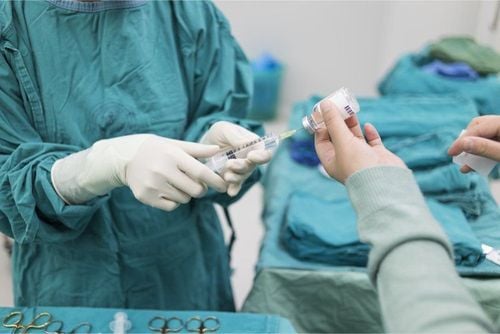
Morphine and benzodiazepine pre-anesthetic drugs have inhibitory effect on the respiratory center, especially in elderly patients, patients in weak condition, lack of circulating volume.
80% of cases of respiratory arrest due to intravenous anesthetic Thiopental, Propofol... This side effect depends on injection speed, injection concentration.
During anesthesia, the patient should be allowed to breathe on their own or with a mask, the risk of hypoventilation occurs more due to the retraction of the tongue.
The respiratory failure phase is associated with morphine analgesics, muscle relaxants, and hypothermia, especially in young children.
Respiratory failure can be caused by a blockage such as a broken tooth, forgotten gauze or a hematoma after thyroid surgery.
When the patient is in respiratory failure, it is necessary to quickly remove the foreign body in the airway, give the patient oxygen and use muscle relaxants, morphine antagonists and assisted ventilation.
Hypoxia This condition occurs when the oxygen transported to the cells is not enough. It may be due to the oxygen tank running out, endotracheal tube retraction, endotracheal tube folding, increased sputum secretion, leakage in the ventilator system.
Patients have symptoms of decreased breathing, changes in respiratory and circulatory rates such as pneumonia, bronchospasm, atelectasis. Oxygen carrying capacity decreases as in anemia, acidosis, hypothermia...
In this case, if the patient is breathing by machine, they must switch to manual respiration with 100% oxygen to check the tension of the oxygen. lung. Quickly listen to the lungs to check the position of the endotracheal tube. Suction blood or secretions. Check the anesthesia machine and ventilator system for leaks.
Anthrax The cause of anthrax is: The respiratory center is inhibited by inhalation anesthetics, morphine or barbituric drugs, benzodiazepines; Neuromuscular blockade after epidural, spinal anesthesia; Bronchospasm causes increased airway resistance; Diseases of the central nervous system such as: tumors, anemia...; Increase CO2 production such as CO2 absorption during intra-abdominal injection or after removal of the gauze
Treatment: If the patient forgets to breathe after anesthesia due to the effects of drugs of the Morphin family, the antagonist Naloxone should be used. Use respiratory support measures such as: artificial respiration, intubation. CO2 such as CO2 absorption at the time of intra-abdominal injection or after removal of the gauze, malignant high fever. Adjust ventilator to correct high CO2.
Fix the cause of CO2 reabsorption during exhalation such as increasing the air flow in the machine. Treatment of malignant hyperthermia.

2.2. Circulatory complications
Decrease in arterial blood pressure
Causes of arterial hypotension during anesthesia include:
Decreased cardiac output, myocardial insufficiency: Bradycardia, cardiac dysfunction in coronary artery disease, valvular disease. Anesthetics have direct myocardial depressant effects... Reduce vascular resistance: Halogenated anesthetics can cause direct vasodilation. Sympathomimetics are common in epidural or spinal anesthesia. Septic shock causes vasoactive substance to be released. Allergic reactions or surgical manipulations such as removing the gauze, pulling visceral organs. Reduced venous return: Compression of the superior and inferior vena cava due to surgery or the uterus pressing on the inferior vena cava. Increased pressure in the right atrium as thoracic pressure increases. Decrease in circulating volume: Lack of circulating volume before surgery but not enough compensation such as: gastrointestinal leakage, blood loss or polyuria due to insipidus, diabetes. To treat it, it is necessary to:
Put the patient in a low head position Transfuse blood or fluids, use vasopressors if necessary Treat causes of low blood pressure Treat arrhythmias Use inotropic drugs Heart Use atropine High blood pressure
Cause:
Patient has pre-existing high blood pressure Shallow anesthesia, inadequate analgesic dose Hypoxia, elevated blood CO2 Overdosage of ketamine anesthetics or use of anticonvulsant drugs pulses such as ephedrine Anesthetized patients with distended bladder Infusion overdosage
Note: anesthesia is deep enough so that the patient is not stimulated for surgery. Limit and treat immediately when the patient lacks oxygen, excess CO2. Use of antihypertensive drugs such as vasodilators, beta-blockers, and alpha-blockers.
Bradycardia
Slow heart rate when the measured heart rate is less than 60 beats/min. The cause is due to:
Heart diseases such as myocardial infarction. aspiration oropharyngeal or laryngeal stones, especially in young children; directly squeeze the eyeball; pull the peritoneum or spermatic cord... Use synthetic morphine drugs, cholinesterase antagonists, respiratory anesthetics, spinal anesthetics, epidurals. Intracranial pressure elevation Treatment:
For patients with complete AV dissociation, before surgery, a pacemaker should be installed for bradycardia due to vagal reflex, the stimulation must be stopped. Atropine 10 mcg can be given intravenously. /kg. If Atropine treatment is not effective, use Isuprel If volume is low, intravenous fluids should be reduced. Halogen anesthetic dose is reduced or substituted with another anesthetic. Tachycardia
Sinus tachycardia is when the measured heart rate is above 100 beats/minute in an adult.
Causes:
Low blood pressure Lack of circulating volume Insufficient pain relief or anxiety Lack of oxygen, too much CO2 Thyroid toxicity, adrenal tumors Certain drugs can cause an increase in heart rate such as: Atropin, Dopamine... Heart rate increases during induction of anesthesia, intubation Patient has a history of tachyarrhythmia, atrial flutter, atrial fibrillation ... Treatment:
Give the patient oxygen For more deep sleep Add more analgesics Treat cause of hypovolaemia Inject Xilocaine topically or intravenously to prevent tachycardia during intubation and extubation If paroxysmal supraventricular tachycardia may press on sinuses Or taking calcium-blockers, ventricular tachycardia can be used with Beta-blockers, Amiodaron, and Digitalin. Modern anesthesia is generally safe. However, each method has the risk of side effects or complications affecting the patient's health. Some complications are temporary, while others can leave long-term sequelae. Therefore, patients need to choose for themselves a reputable medical examination and treatment address, a doctor with high professional qualifications, as well as strictly follow the instructions in treatment to avoid complications.
Please dial HOTLINE for more information or register for an appointment HERE. Download MyVinmec app to make appointments faster and to manage your bookings easily.




